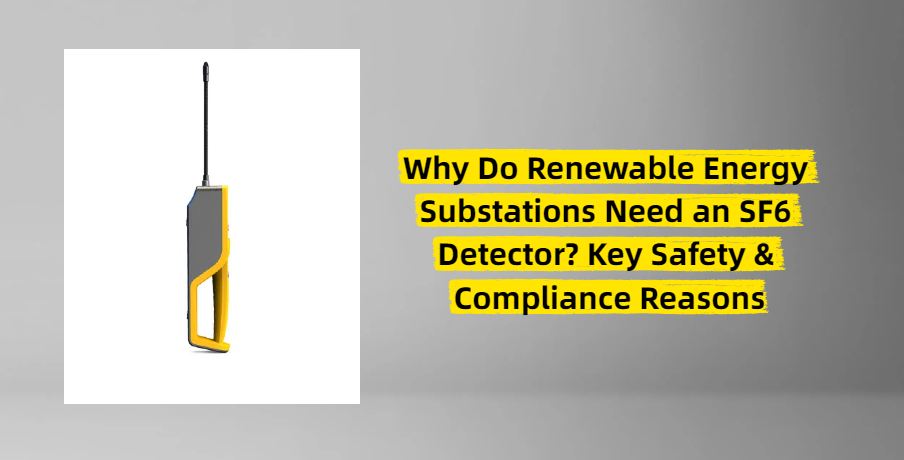
Why Do Renewable Energy Substations Need an SF6 Detector? Key Safety & Compliance Reasons
As global renewable energy capacity (wind, solar, hydro) grows exponentially—with the International Energy Agency (IEA) projecting 90% of new power capacity by 2030 to be renewable—substations have become the backbone of energy transmission. These facilities rely on high-voltage equipment to stabilize power flow and connect renewable sources to the grid. A critical component in this infrastructure? Sulfur hexafluoride (SF6), a gas valued for its exceptional insulation and arc-quenching properties. However, SF6 is also a potent greenhouse gas (23,500 times more heat-trapping than CO₂ over 100 years) with toxic decomposition byproducts. This is where an SF6 detector for renewable energy substation becomes non-negotiable: it safeguards compliance, equipment reliability, and human health.
The Role of SF6 Gas in Renewable Energy Substations
Renewable energy sources (e.g., wind farms, solar parks) produce intermittent power, requiring substations to regulate voltage, manage load fluctuations, and ensure smooth grid integration. High-voltage switchgear, circuit breakers, and transformers in these substations depend on SF6 for two key reasons:
Superior Insulation: SF6’s dense molecular structure prevents electrical arcing in high-voltage environments, even in humid or dusty conditions common in outdoor renewable substations.
Arc Quenching: During equipment switching (e.g., fault isolation), SF6 rapidly cools and extinguishes electrical arcs, protecting costly gear from damage.
Unlike traditional substations near urban centers, renewable substations are often located in remote areas (e.g., mountainous wind farms, desert solar parks). This isolation makes SF6 leaks harder to detect manually—amplifying the need for dedicated SF6 detectors.
Why SF6 Detectors Are Critical for Renewable Substations
Without proper monitoring, SF6 leaks pose three existential risks to renewable energy operations:
1. Environmental Compliance
Global regulations (e.g., the Kyoto Protocol, EU F-Gas Regulation) and national policies (e.g., U.S. EPA’s GHG Reporting Program) mandate strict limits on SF6 emissions. Renewable energy projects—often marketed as “sustainable”—face reputational and financial penalties if they violate these rules. An SF6 detector for renewable energy substation provides real-time leak data, enabling operators to trace sources, repair leaks, and avoid fines.
2. Equipment Reliability
SF6 leaks reduce insulation performance in switchgear and breakers. In renewable substations, where downtime can halt power delivery to thousands of homes, this risk is costly: a single transformer failure in a solar substation can cause $100,000+ in losses daily. Detectors alert teams to leaks early (even at ppm-level concentrations), preventing catastrophic equipment failure and unplanned outages.
3. Worker Safety
SF6 is non-toxic in its pure form, but leaks in enclosed spaces (e.g., substation control rooms) can displace oxygen, causing asphyxiation. When exposed to high temperatures (e.g., electrical faults), SF6 decomposes into toxic gases like sulfur dioxide (SO₂) and 氟化氢 (HF), which irritate the lungs and eyes. For maintenance teams visiting remote substations, a portable or fixed SF6 detector is a life-saving tool.
Key Features to Select the Right SF6 Detector for Renewable Substations
Not all SF6 detectors are designed for the unique challenges of renewable energy sites. Prioritize these features:
- High Detection Precision: Choose detectors that measure leaks as low as 1 ppm (parts per million)—critical for early detection in large, outdoor substations.
- Rugged Environmental Resistance: Renewable substations endure extreme conditions (e.g., -30°C to 60°C in desert solar parks, salt spray in coastal wind farms). Opt for IP67/IP68-rated detectors with corrosion-resistant housing (e.g., stainless steel) to withstand dust, moisture, and vibration.
- Real-Time Data & Remote Monitoring: Look for detectors with IoT connectivity (e.g., 4G, LoRaWAN) to send alerts to central dashboards. This is essential for unmanned renewable substations, where on-site staff are scarce.
- Dual-Mode Operation: Fixed detectors for permanent monitoring (e.g., near switchgear) and portable models for patrols cover all use cases. Portable detectors should be lightweight (≤1kg) for easy transport in remote areas.
- Low Maintenance: Select detectors with long calibration intervals (12–24 months) and rechargeable batteries (≥8 hours of use) to minimize downtime in hard-to-reach sites.
Real-World Applications: SF6 Detectors in Wind & Solar Substations
Wind Farm Substations
Coastal and mountain wind farms face high humidity and salt exposure. A fixed SF6 detector with anti-corrosion sensors installed near circuit breakers can monitor leaks 24/7, while portable detectors help technicians inspect turbines’ auxiliary substations during routine checks.
Solar Park Substations
Desert solar substations experience extreme temperature swings. Detectors with wide temperature ranges (-40°C to 70°C) ensure accurate readings even during midday heat. IoT-enabled models integrate with solar park SCADA systems, triggering automatic alerts if leaks exceed safe levels.
The Future of SF6 Detection in Renewable Energy
As renewable energy scales, SF6 detector technology is evolving to be more sustainable and intelligent. Next-gen models will include AI-powered leak prediction (using historical data to forecast risks), solar-powered operation (reducing reliance on grid power), and multi-gas detection (monitoring SF6 and its toxic byproducts simultaneously). For renewable project developers, investing in a high-quality SF6 detector isn’t just a compliance box-check—it’s a long-term investment in operational efficiency and sustainability.
In summary, an SF6 detector for renewable energy substation is indispensable for balancing the growth of clean energy with environmental responsibility and safety. By choosing a detector tailored to the unique demands of renewable sites, operators can protect their equipment, their teams, and the planet—while keeping renewable power flowing reliably.

